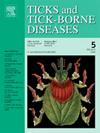Survey of tick-borne relapsing fever borreliae in southern and southeastern Kazakhstan
IF 3.1
2区 医学
Q2 INFECTIOUS DISEASES
引用次数: 0
Abstract
Tick-borne relapsing fever group borreliae (TBRFGB) are spirochetes that cause disease in humans and animals. Little is known about the prevalence of TBRFGB infections in ticks and humans in Kazakhstan. A total of 846 ticks belonging to ten species of the family Ixodidae and three species of the family Argasidae were collected from the vegetation, poultry shelters, domestic ruminants, bitten humans, pigeons, dogs and house walls in four oblasts of the southern and southeastern regions of Kazakhstan. The ticks were subjected to DNA extraction and identification of TBRFGB by conventional PCR using primers targeting flagella subunit B (flaB), glycerophosphodiester phosphodiesterase (glpQ) and P66 porin (P66) genes. The overall infection rate of TBRFGB in the ticks was 6.2 % (46/846). TBRFGB DNA was identified in Ixodes persulcatus (5.5 %; 26/477), Ornithodoros tartakovskyi (6 %; 2/36) and Argas persicus (13.4 %; 18/134) ticks. Partial sequencing of flaB, glpQ and P66 genes identified Borrelia miyamotoi in I. persulcatus and Borrelia anserina in A. persicus. To detect the presence of B. miyamotoi infection in people in the study region, we performed serological analysis of samples collected from 42 patients admitted to hospital with fever of unknown etiology or with a history of a tick bite. The analysis revealed IgM and IgG antibodies against one or several B. miyamotoi antigens in 10 % and 5 % of patients, respectively. The data obtained provide strong evidence of the presence of B. miyamotoi and B. anserina in the southern and southeastern regions of Kazakhstan, underscoring the need for increased awareness of potential infections caused by these borreliae in these regions.
哈萨克斯坦南部和东南部蜱传复发热包虫病调查
蜱媒复发性热群博氏螺旋体(TBRFGB)是一种螺旋体,可导致人类和动物疾病。在哈萨克斯坦,人们对蜱虫和人类感染 TBRFGB 的情况知之甚少。研究人员从哈萨克斯坦南部和东南部四个州的植被、家禽栖息地、家养反刍动物、被叮咬的人类、鸽子、狗和房屋墙壁上共收集到 846 只蜱虫,这些蜱虫隶属于 Ixodidae 科的 10 个物种和 Argasidae 科的 3 个物种。对蜱进行了 DNA 提取,并使用针对鞭毛亚基 B(laB)、甘油磷酸二酯磷酸二酯酶(glpQ)和 P66 孔蛋白(P66)基因的引物,通过传统 PCR 方法对 TBRFGB 进行了鉴定。蜱虫的 TBRFGB 总感染率为 6.2 %(46/846)。在Ixodes persulcatus(5.5%;26/477)、Ornithodoros tartakovskyi(6%;2/36)和Argas persicus(13.4%;18/134)蜱中发现了TBRFGB DNA。通过对 flaB、glpQ 和 P66 基因的部分测序,在 I. persulcatus 中发现了 Borrelia miyamotoi,在 A. persicus 中发现了 Borrelia anserina。为了检测研究地区人群中是否存在宫本鲍瑞虫感染,我们对 42 名病因不明或有蜱虫叮咬史的发热住院病人采集的样本进行了血清学分析。分析结果显示,分别有 10% 和 5% 的患者体内存在针对一种或几种宫本虫抗原的 IgM 和 IgG 抗体。所获得的数据有力地证明了在哈萨克斯坦南部和东南部地区存在 B. miyamotoi 和 B. anserina,强调有必要提高这些地区对这些包虫病可能造成的感染的认识。
本文章由计算机程序翻译,如有差异,请以英文原文为准。
求助全文
约1分钟内获得全文
求助全文
来源期刊

Ticks and Tick-borne Diseases
INFECTIOUS DISEASES-MICROBIOLOGY
CiteScore
6.90
自引率
12.50%
发文量
185
审稿时长
6-12 weeks
期刊介绍:
Ticks and Tick-borne Diseases is an international, peer-reviewed scientific journal. It publishes original research papers, short communications, state-of-the-art mini-reviews, letters to the editor, clinical-case studies, announcements of pertinent international meetings, and editorials.
The journal covers a broad spectrum and brings together various disciplines, for example, zoology, microbiology, molecular biology, genetics, mathematical modelling, veterinary and human medicine. Multidisciplinary approaches and the use of conventional and novel methods/methodologies (in the field and in the laboratory) are crucial for deeper understanding of the natural processes and human behaviour/activities that result in human or animal diseases and in economic effects of ticks and tick-borne pathogens. Such understanding is essential for management of tick populations and tick-borne diseases in an effective and environmentally acceptable manner.
 求助内容:
求助内容: 应助结果提醒方式:
应助结果提醒方式:


